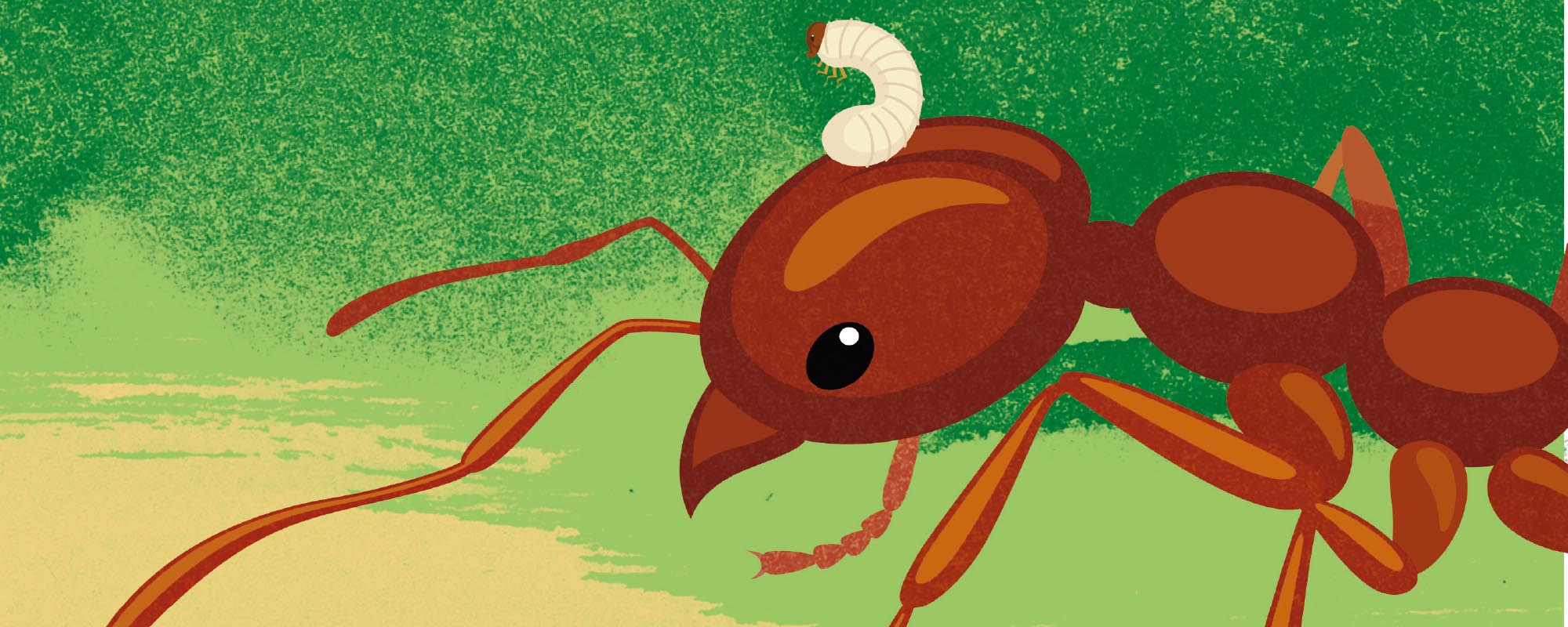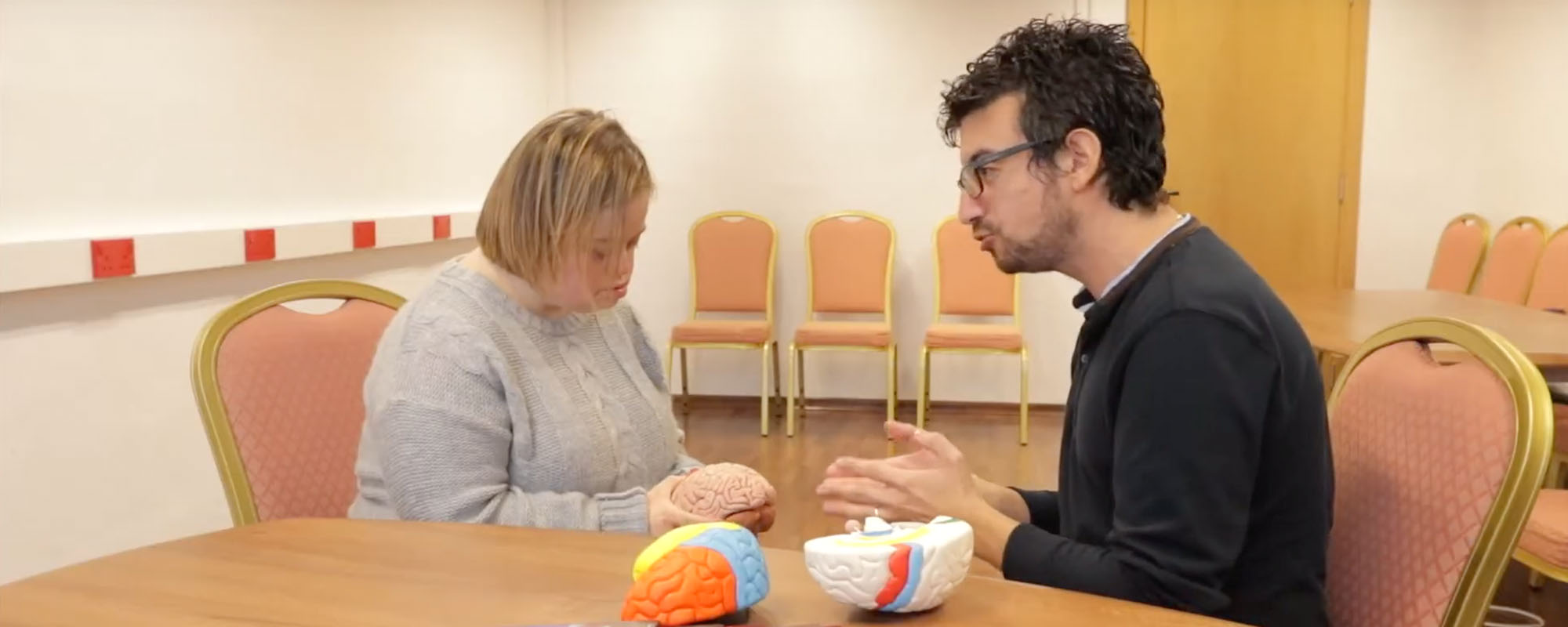For the love of ants
The relationships between ants and other organisms can be just as complex as the subterranean networks they tunnel. Thomas Cassar takes a closer look at how these insects farm, steal, and co-habit.
Some ants’ tendency to ‘farm’ aphids (plant sap-sucking insects) for their sweet honeydew is decades-old knowledge. Cynics use this phenomenon to downplay the achievements of humans: look, an animal the size of a sesame seed had mastered agriculture long before human beings.
But aphids aren’t alone in this world of ant-coexistence. There’s a specialised group of animals which ignore the opinion of disgruntled roommates worldwide, seeking out the company of others. These are the myrmecophiles, literally ‘ant-lovers’. Such a phrase may conjure up an image of a great expert, maybe someone like the American biologist E. O. Wilson, pouring over an anthill (that would be a myrmecologist). Myrmecophile is an organism that just can’t live without ants.
The Ant Nest Ecosystem
Ants’ nests are prime real estate for the enterprising and the brave. If you can somehow get on good terms with your ant hostesses, you’re guaranteed a temperature-regulated shelter free of predators. And if there’s one thing all living things agree upon, it’s that you don’t say ‘no’ to a free bed and meal. But there’s always an adaptive fee to pay.

There are chambers for the brood, guards, the queen, and for food storage. The nest’s surroundings can yield rich pickings, too — the foraging routes, for instance. But if you’re tiny, good at holding on for dear life, or look like a nightmare straight out of Ridley Scott’s Alien, then the bodies of ants can be your home.
Many mites — tiny arachnids — feed on ants as parasites. The highly specialised mite Macrocheles rettenmeyeri just can’t resist a sip of army ant blood, and to get its meal it latches onto the ant’s last foot segment. But army ants can’t do their job with a bad foot; they form protective clusters by hooking each other’s claws together. So the mite earns its keep by converting its whole body into an extra ant’s foot. When the ant needs to use its claws as gripping hooks, the mite’s legs bend to serve the same purpose.
Antennophorus mites are another kind of ‘considerate’ parasite. Taking up positions on either side of the ant’s head or abdomen, they create a balanced load. Although it would be better for the ant if these thieves of regurgitated food weren’t there at all, this balancing act somewhat reduces the problem.
Patting someone’s head for a snack might not be recommended in human society, but for ants, sharing regurgitated food after a few antennae-taps is a way to communicate and strengthen social bonds among nest-mates. It’s also nutrition on tap for intruders who know how to say the magic word. So apart from lapping up food as it is passed from one ant to another, Antennophorus stroke the ant’s antennae with their legs in a way which mimics the touch signals from other ants requesting food — and hey presto, the host presents a globule of food, glorious food.
The trails of foraging ants can also offer an easy meal. One species which takes advantage is the Amphotis beetle. It waits for ants heavily laden with food, and like a highwayman of the undergrowth, gets the ant to regurgitate food by drumming on its head with its antennae.
Antennophorus stroke the ant’s antennae with their legs in a way which mimics the touch signals from other ants requesting food — and hey presto, the host presents a globule of food, glorious food.
The myrmecophile VIPs have adapted to gain exclusive access to the most precious confines of any nest: the brood chamber. Here, ants tend to their larvae day and night, guarding them fiercely, and feeding them generously. To live a luxurious life here, you need to get under the radar. The ingenious larvae of beetles have learnt to not only mimic the food-begging behavior of the ants’ own larvae, but they mask their intrusive presence by releasing a pheromone which triggers brood-tending behaviour. The beetle has mastered these mechanisms so well that its larvae end up getting a bigger helping of food than the young ants themselves.
You scratch my thorax, and I’ll scratch yours
Many myrmecophilous relationships are truly reciprocal. Some caterpillars of blue butterflies (Lycaenidae) seek out ants’ care and protection in exchange for a concentrated sugar solution secreted by a gland on their back. In some treehopper species, which exchange honeydew for protection, females abandon their young early on to the care of their farmers, being able to produce more clutches of eggs in the meantime.
The benefits of reciprocity can be so great that they may change the way ants live their lives and build their nests. Malaysian herdsmen ants (Dolichoderus cuspidatus) have no permanent nests, instead constructing shelters out of their own living bodies to protect their livestock — honeydew-producing mealybugs. When the mealybugs’ plants run dry and all seems lost, the ants pull up their socks and efficiently transport the mealybugs to fresher pastures. The discovery of this behaviour in 1985 was the first known case of non-human nomadic herding.
To live a luxurious life here, you need to get under the radar.
One need not travel to far-flung forests to appreciate the world of ants. Prof. David Mifsud (Institute of Earth Systems, University of Malta) recently worked on a study which brought the total known ant species in the Maltese Islands up to 70, a world with its own cast of characters. There are clean-up crews of blind, white woodlice scavenging the nests of harvester ants. Golden nicoletiidae silverfish zoom around, feeding on debris and stealing the odd morsel of regurgitated food and getting away with it, because the silverfish have learned to copy their hosts’ nest’s unique identifying odour. A sub-endemic, 4mm-long cricket (Myrmecophilus baronii) lives with carpenter ants, its wings lost in the course of evolution, along with much of its eyesight. A ground beetle (Siagona europaea) uses the secretions of its ant prey to make itself less detectable as it hunts.
From an ant’s perspective, living with other insects rather than eating them may ensure that precious resources are always in stock — much the same reason why humans went from hunter-gatherers to farmers. For the myrmecophile, there is one good reason amongst many for moving in with ants. By providing the ants with a useful resource, you avoid becoming their breakfast, lunch, or dinner. If you can’t beat them, join them.
Further reading:
Mifsud D. & Lapeva-Gjonova, A. (2019). ‘Additions to the ant fauna (Hymenoptera: Formicidae) of the Maltese Islands.’ ARPHA Conference Abstracts 2: e46475.
Talarico, F., Bonacci, T., Brandmayr, P., Dalpozzo, R., De Nino, A., Giglio, A., Tagarelli, A. & Zetto Brandmayr, T. (2009). ’Avoiding ant detection in Siagona europaea Dejean 1826 (Coleoptera Carabidae): an evolutionary step towards true myrmecophily.’ Ethology Ecology & Evolution, 21(1), 45–61. doi: 10.1080/08927014.2009.9522510.
Von Beeren, C., Schulz, S., Hashim, R., & Witte, V. (2011). ’Acquisition of chemical recognition cues facilitates integration into ant societies.’ BMC Ecology, 11(1), 30. doi: 10.1186/1472-6785-11-30.
When your job captures ‘every breath you take’
Are you a doctor? A friend? A mother? An athlete? All of the above? Kieran Teschner talked to Dr Patricia Bonello from the Department of Social Policy and Social Work (University of Malta) about the relationship between people and their profession, and how music can capture this relationship.
Continue readingYoung motherhood is not all doom and gloom
Author: Dr Andreana Dibben
Teenage mothers are all too familiar with the phrase ‘children raising children’. From professionals to politicians, media, and even strangers on the bus, everybody has something to say about the perils of teenage pregnancy. Yet, when I spent two years attending a weekly mother and baby support group, hanging out with 24 young mothers (ages 13 to 21) for my doctoral research, I learnt that the reality was much more complex than a clichéd slogan.
My research looked into the lived experiences of pregnant young women and young mothers in Malta, specifically capturing detailed insights into how participants defined their sexual, reproductive, and mothering choices in the context of the policies, services, and discourses that framed their lives. Many participants considered being a mother as a deeply positive experience. Knowing full well about the teen motherhood stigma, they reclaimed the pejorative phrase ‘children raising children’ and saw their young age as advantageous because ‘you and your child grow together’. They felt they had more physical energy to carry out motherhood-related tasks, and expected a better mother-child bond due to a minimal generation gap.

What impressed me was that teenage mothers know how to care. The level of attentiveness and the responsibility with which young mothers cared for their children starkly contrasted with society’s stereotypes. Many participants had assumed caring roles and responsibilities from a young age, so caring for children was something they had learnt to do early on.
Pregnancy was not always accidental as is publicly presumed. It was often an active choice, framed as a positive step towards family formation. Research participants saw their early romantic relationships, often with older men, as an expression of psychological maturity. Some claimed the baby was healing the sufferings of their difficult childhood.
There is no denying that some pregnancies were not planned. Often, this was due to imbalanced power in relationships and control over sexuality. ‘We didn’t use condoms because he did not want to’ or ‘he did not want me to go on the pill as he saw it as a free pass to screw around’ were common phrases in the interviews.
The feminist lens helps detect gendered and class-based attitudes and behaviours, particularly conspicuous in the young mothers’ stories. Popular culture’s heterosexual imagery shapes young women’s reproductive choices early on. Framed by this ideology, the creation of a nuclear family is seen as the ultimate goal of a romantic relationship. Even for unplanned pregnancies, an ethic of responsibility and the stigma on abortion further pressure them towards choosing motherhood. Mothers are then expected to be completely selfless in their ‘sacred’ role. As Mireille, an 18-year-old mum who accidentally got pregnant at 15, put it: ‘I used to feel from the start that a huge responsibility was coming upon me. Now I’m not sorry that I had her though… In the end you do everything for your children.’
Yet my research shows that young mothers are not passive in this process. Choosing motherhood in the unequal context they inhabit, young mothers take their lives in their own hands. They challenge the patriarchal ideology that values only certain kinds of motherhood as ‘good’ — it must be based on marriage, economic independence, and a mature biological age. Most young mothers made active decisions when faced with dominant male partners, patronising professionals, and stigmatising incidents. Motherhood may have exacerbated disadvantage in many situations, but it also gave a sense of empowerment.
This study shed light on how young mothers valued their experience over social, economic, and cultural constraints. They consider motherhood as a positive life choice rather than a limitation. In the words of Isabel, a 19-year-old mum of a two-year-old: ‘The most important thing is how you feel inside. I feel great joy and satisfaction. Even though you’re 16, you can still raise your kids well. And that’s what matters at the end of the day.’
Isabel’s message is clear: Young mothers are making a valuable contribution to society. Instead of pity, they need respect and support.
Speaking the language of machines
How does artificial intelligence figure out human language to create its own learning curve? Christian Keszthelyi talks to one of Malta’s leading AI researchers, Dr Claudia Borg.
Continue readingJournalism’s gendered risks
Journalists find themselves increasingly interfered with or intimidated, facing violence and threats, surveillance, and prosecution. Prof. Marilyn Clark shows how these dangers are different for men and women.
Continue readingMaking it in a male-dominated world
Seeking a job and growing in it may seem like a commonplace thing nowadays. Yet for women at the top of their game today, the path was fraught with hurdles and required the utmost determination. THINK takes a moment out of the incredibly busy lives of three central women at the University of Malta (UM) to discuss their life stories and challenges quashed. Words by Martina Borg.
Continue readingAccessible science: Denise Camilleri interviews Claude Bajada
Can we look inside our brains? Denise Camilleri of Opening Doors Malta interviews Dr Claude Bajada of Department of Physiology & Biochemistry about the science of the brain.
Continue reading









